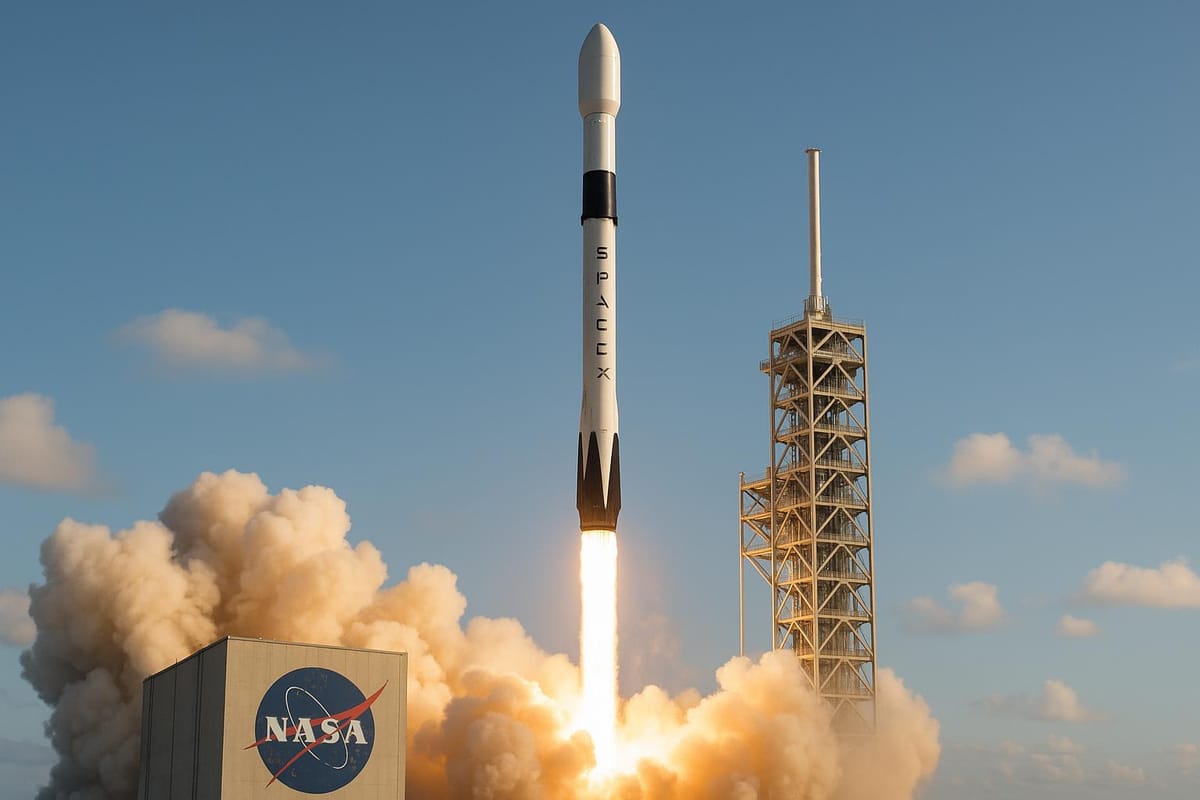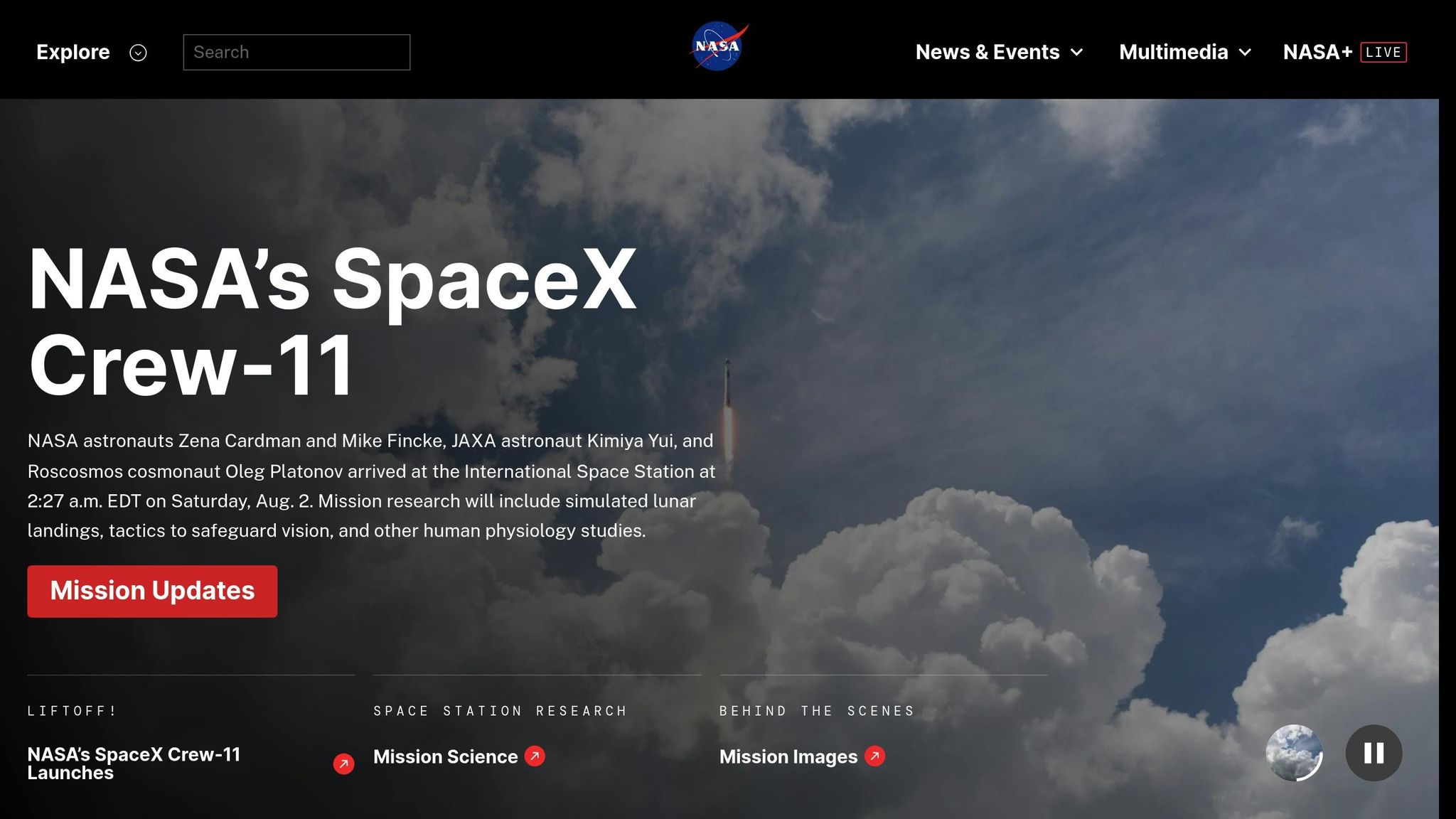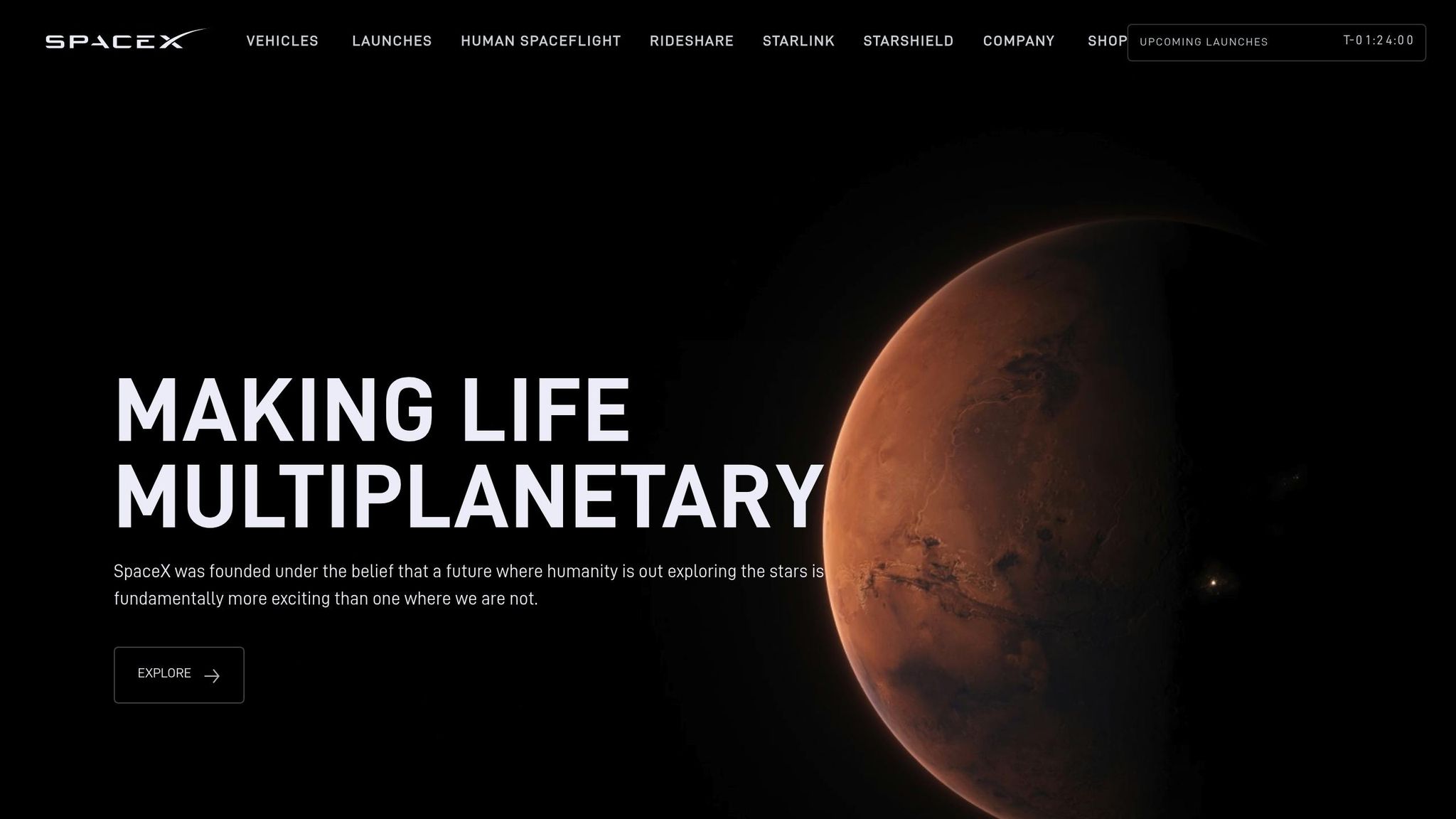NASA and SpaceX: A Growing Partnership
Explore how the partnership between two leading space organizations is revolutionizing space exploration through innovation and cost efficiency.

The partnership between NASA and SpaceX has reshaped U.S. space exploration by combining NASA's expertise with SpaceX's cost-efficient innovations. This collaboration has reduced costs, increased efficiency, and accelerated progress in human spaceflight. Key highlights include:
- Lower Costs: SpaceX charges ~$55M per astronaut seat to the ISS, down from NASA's previous $90M reliance on Russia's Soyuz.
- Reusable Rockets: SpaceX's technology saves NASA ~$10B annually.
- Market Growth: SpaceX leads the U.S. orbital launch market, handling ~87% of launches in 2024.
- Shared Expertise: NASA provides research, testing, and facilities, while SpaceX delivers rapid engineering and reusable spacecraft.
Despite challenges like financial reliance on government contracts and safety concerns, this partnership is advancing space exploration, with a focus on future Mars missions and the Artemis program. By blending public and private strengths, NASA and SpaceX are setting new benchmarks for the space industry.
1. NASA

Collaboration Approach
Over the last two decades, NASA has reimagined how it approaches space exploration. Instead of managing everything internally, the agency shifted to building competitive partnerships with private companies. A major turning point came in 2019 when NASA adopted a vision to create a thriving low Earth orbit marketplace. In this model, NASA acts as just one of many customers rather than the sole operator.
Central to this strategy are Space Act Agreements (SAAs), which allow NASA to collaborate with private entities while sharing both risks and rewards. Currently, NASA is involved in over 80 active missions in partnership with private space companies.
"It is great to see companies invest their own capital toward innovative commercial space capabilities, and we've seen how these types of partnerships benefit both the private sector and NASA", said Phil McAlister, director of commercial spaceflight at NASA Headquarters.
This approach taps into the private sector's creativity and cost-effectiveness while ensuring NASA's oversight and focus on safety. By embracing this model, NASA has gained a foothold in a space industry valued at $400 billion as of 2022, with forecasts suggesting it could surpass $1 trillion by 2040. Up next, we’ll dig into NASA’s technical and operational contributions that make these partnerships thrive.
Key Contributions to Joint Projects
NASA’s decades of technical expertise and cutting-edge facilities have been critical in supporting SpaceX’s advancements. Through the Commercial Crew Program, NASA has provided essential research, testing, and technical insights to ensure the success of joint missions.
One standout example is NASA's Ames Research Center, which played a key role in SpaceX’s Dragon spacecraft development. The center provided the technology for Dragon’s primary heat shield, made from Phenolic Impregnated Carbon Ablator (PICA) - a lightweight, durable material first invented at Ames in the early 1990s.
NASA’s testing facilities have also been instrumental. The Arc Jet Complex at Ames can simulate spacecraft reentry conditions, reaching temperatures as high as 3,000 degrees Fahrenheit. In 2018, it conducted tests specifically for the Crew Dragon capsule. Meanwhile, the Unitary Plan Wind Tunnel facility carried out aerodynamic testing to refine SpaceX’s ascent and launch abort systems. These efforts drew heavily on NASA’s expertise from developing the Orion crew capsule.
This collaboration has proven its reliability. SpaceX’s Crew-11 mission marked the 12th time the company successfully launched NASA astronauts to the International Space Station (ISS), underscoring the strength of this partnership.
Benefits Gained
NASA’s collaboration with SpaceX has delivered substantial financial and technological advantages. SpaceX now manages about two-thirds of NASA’s launches, charging around $62 million per flight - significantly less than the cost of rockets from United Launch Alliance.
Through a $3.1 billion investment in SpaceX under the Commercial Crew Program, NASA helped develop the Crew Dragon spacecraft, which now provides dependable astronaut transportation to the ISS. Over the past decade, SpaceX has charged NASA an average of $106 million per Falcon 9 launch, a major cost reduction compared to earlier providers.
Beyond cost savings, the partnership has sparked technological breakthroughs. SpaceX’s reusable rocket technology has made satellite launches far more affordable. This innovation allows NASA to allocate more resources to ambitious deep-space missions while maintaining reliable access to low Earth orbit.
"NASA's Commercial Crew Program has delivered on its goal of safe, reliable, and cost-effective human transportation to and from the International Space Station from the United States through a partnership with American private industry. This partnership is opening access to low Earth orbit and the International Space Station to more people, more science, and more commercial opportunities", said Jason Costa, NASA.
These advancements not only reduce mission costs but also free up resources for exploring deeper into space. The collaboration has firmly positioned NASA within the rapidly growing commercial space sector, where SpaceX now commands over 60% of the market share. This public-private partnership model has become a blueprint for future space exploration, showcasing how collaboration can drive innovation while keeping costs in check.
2. SpaceX

Collaboration Approach
SpaceX has taken a bold and forward-thinking approach in its partnership with NASA, standing apart from the more traditional aerospace contractors. Instead of waiting for NASA to outline every detail, SpaceX takes the initiative to develop new technologies and services, which NASA can then test and integrate into its missions.
A great example of this dynamic was NASA's Starling 1.5 experiment in March 2025. This showcased SpaceX's proactive screening service for autonomous maneuvering in low Earth orbit. Nathan Benz, the project manager for Starling 1.5 at NASA Ames, highlighted the unique shift in roles:
"Usually, SpaceX takes the responsibility to move out of the way when another operator shares their predicted trajectory information."
In this case, the experiment flipped the script. NASA’s Starling system took on the responsibility of maneuvering, relying on SpaceX's screening service to autonomously avoid a close approach with a Starlink satellite. The success of this test demonstrated how well the system performed in real-time.
This collaborative approach goes beyond individual experiments. Through programs like the Collaborations for Commercial Space Capabilities-2 (CCSC-2), SpaceX and NASA are working together to build a comprehensive low Earth orbit framework. This effort combines the near-term evolution of the Dragon spacecraft with the ongoing development of Starship. It’s a partnership that fuels innovation and sets the stage for SpaceX’s continuing advancements.
Key Contributions to Joint Projects
SpaceX has significantly expanded NASA’s capabilities through its groundbreaking technologies and cost-efficient solutions. A key achievement in this partnership is the Commercial Crew Program. Under this initiative, SpaceX developed the Dragon spacecraft and the Crew Dragon capsules, restoring the United States' ability to launch astronauts from American soil. SpaceX’s rapid engineering advancements helped bring Crew Dragon to readiness for crewed missions faster than expected.
One of SpaceX’s standout contributions is its reusable rocket technology, typified by the Falcon 9. This innovation has slashed launch costs, making space more accessible to NASA and commercial clients alike. The reliability of these rockets is evident in the ongoing streak of successful crewed launches. NASA is now collaborating with SpaceX to extend the certification of the Dragon capsules, increasing their lifespan from five to as many as 15 flights per capsule.
SpaceX’s role isn’t limited to crew and cargo transport. The company has also taken on specialized missions, such as the Imaging X-Ray Polarimetry Explorer (IXPE). This astrophysics mission aims to deepen our understanding of how gravitational, electric, and magnetic fields interact. These contributions highlight how public–private partnerships are reshaping the future of U.S. space exploration.
Benefits Gained
SpaceX’s technological achievements have not only advanced space exploration but also bolstered its financial and market position. Early investments from NASA were instrumental in cutting the Falcon 9 development costs by about half, helping establish SpaceX as a leader in the space industry.
These investments were structured as milestone-based contracts, including $396 million under the COTS program in 2006, $1.6 billion for Commercial Resupply Services in 2008, $75 million in 2011 for developing a launch escape system for Dragon, and the Commercial Crew Transportation Capability contract in 2014.
This financial backing has paid off. SpaceX achieved $8.7 billion in revenue in 2023, with $3.5 billion coming from launch services alone. Beyond the monetary gains, SpaceX has benefited immensely from NASA’s wealth of technical expertise and access to its facilities. Phil McAlister, NASA’s director of commercial spaceflight, explained:
"The companies can leverage NASA's vast knowledge and experience, and the agency can be a customer for the capabilities included in the agreements in the future. Ultimately, these agreements will foster more competition for services and more providers for innovative space capabilities".
How NASA and SpaceX Work Together
Advantages and Disadvantages
Taking a closer look at the NASA–SpaceX partnership reveals a mix of strengths and challenges that shape the trajectory of modern space exploration. This collaboration brings together two distinct entities, each with unique capabilities and limitations. By examining these dynamics, we can better understand how their combined efforts are redefining the future of space travel.
| Organization | Advantages | Disadvantages |
|---|---|---|
| NASA | • Decades of technical expertise and institutional knowledge • Access to top-tier facilities and testing infrastructure • Strong international partnerships and diplomatic ties • Rigorous safety protocols and mission oversight • Reliable funding through federal budgets |
• Limited budget flexibility (currently ~0.5% of the federal budget, compared to 4.5% at its peak in 1966) • Slower decision-making due to bureaucratic processes • Political influence impacting long-term planning • Dependence on contractors for launches • High costs with traditional procurement methods |
| SpaceX | • Cost-saving innovations like reusable rockets • Vertical integration – handling design and manufacturing in-house • Quick decision-making and faster development cycles • Proven success with Crew Dragon missions |
• Heavy reliance on government contracts for revenue • Tight development timelines raising safety concerns • Regulatory hurdles and oversight demands • Uncertain profitability for human spaceflight without NASA funding |
These points highlight how NASA and SpaceX complement one another. NASA's deep experience and technical rigor provide a steady hand, while SpaceX's efficiency and innovation help tackle budget constraints. However, the partnership isn't without its hurdles.
Financial and Market Pressures
One key challenge lies in financial stability. SpaceX remains heavily reliant on government contracts, as noted by Victoria Samson of the Secure World Foundation:
"I wouldn't say it's a handout, but SpaceX would not exist without a huge influx of repeated government contracts. To this day, they're still dependent on government customers, though they have commercial customers too."
Currently, SpaceX dominates the U.S. orbital launch market, accounting for 87% of launches in 2024. Yet, this dominance faces threats from emerging competitors, including China's rapidly advancing space capabilities and other commercial players. These shifts could disrupt SpaceX's market position over time.
Technical and Safety Challenges
Ambitious projects like Starship, Starlink 2, and dearMoon present additional risks. Tight deadlines increase the likelihood of technical setbacks, such as stage-separation failures, which could hinder mission success. Both NASA and SpaceX must prioritize robust risk management to navigate these challenges effectively.
Regulatory and Political Complexities
Regulatory and political issues also complicate the landscape. Delays in decision-making, reliance on government contracts, and political influences could skew fair competition or compromise safety. Concerns about weakened oversight from agencies like the FAA and EPA further underscore the need for vigilance.
Sustaining the Vision
Despite these challenges, the partnership continues to push boundaries. Chris Combs, an aerospace engineer at the University of Texas at San Antonio, emphasizes SpaceX's competitive edge:
"More players in the market is good for competition. I think for the foreseeable future it will still be hard to compete with SpaceX on price."
Still, the sustainability of human spaceflight depends on consistent government support, especially for ambitious goals like Mars exploration. Elon Musk recently shared his outlook on the next Mars mission:
"The next Mars opportunity is at the end of next year in about 18 months. I think we'll probably have a 50-50 chance right now because we've got to figure out orbital refilling in order to have enough capability to go to Mars. But if we achieve orbital refilling in time, then we will launch the first uncrewed Starship to Mars at the end of next year."
Balancing innovation with safety, cost efficiency with reliability, and commercial goals with public missions will be critical. The partnership's ability to navigate these competing priorities will determine its future success and its impact on space exploration as a whole.
Conclusion
The NASA–SpaceX partnership represents a transformative chapter in America's space exploration story. By merging NASA's extensive experience with SpaceX's forward-thinking engineering and cost-cutting methods, this collaboration has revolutionized both the economics and the speed of space missions.
Consider this: a seat on the Crew Dragon now costs about $55 million compared to $86 million per astronaut on Russia's Soyuz flights. Meanwhile, a Falcon 9 launch comes in at roughly $67 million, showcasing SpaceX's ability to deliver efficiency without compromising performance. These cost reductions are more than just numbers - they're driving further innovation and reshaping industry standards.
This partnership has also reestablished America's independent access to space. A key milestone was the May 2020 Crew Dragon mission, marking the first crewed flight from U.S. soil since the Space Shuttle program ended. The momentum continued with the Crew-10 mission, stepping in after Boeing's Starliner faced technical setbacks in 2025.
NASA Administrator Bill Nelson summed up the synergy between NASA and SpaceX perfectly:
"You sit down with Elon Musk and he'll tell you he would not be where he is if it were not for NASA. Elon will tell you also, in a moment of truth, that he had a lot of technical problems – as do all of them. And who do they come running to, to help them? NASA."
In 2024, the U.S. achieved an incredible milestone with 155 successful launches, cementing space as a booming economic sector rather than a purely governmental domain. SpaceX's achievements have ignited competition across the industry, encouraging other companies to adopt similar public–private collaboration models.
Looking ahead, this partnership is setting the stage for even greater achievements. SpaceX's involvement in NASA's Artemis program and its ambitious plans for Mars missions demonstrate how the blend of public knowledge and private innovation can push the limits of what's achievable. As Phil McAlister, NASA's director of commercial spaceflight, aptly put it:
"It is great to see companies invest their own capital toward innovative commercial space capabilities, and we've seen how these types of partnerships benefit both the private sector and NASA."
For those eyeing opportunities in the rapidly growing space industry, the NASA–SpaceX collaboration highlights the potential of commercial ventures in this field. Tools like the SpaceX Stock Investment Guide can provide insights for navigating investments in private space companies before they go public.
FAQs
How has the NASA-SpaceX partnership made space missions more affordable and efficient?
The partnership between NASA and SpaceX has transformed the economics and practicality of space exploration. SpaceX's groundbreaking reusable rockets, such as the Falcon 9 and Starship, have slashed launch costs by enabling rockets to be reused multiple times with only minimal upkeep. Take the Falcon 9, for instance - it can be flown more than 10 times, dramatically lowering expenses compared to the traditional single-use rocket systems of the past.
This collaboration has also redefined mission budgets. A seat aboard SpaceX’s Crew Dragon comes with a price tag of around $55 million, a significant drop compared to the much higher costs of earlier spaceflight programs. Thanks to SpaceX's cutting-edge technology and its work with NASA, space exploration is now more affordable and accessible, accelerating progress in the field like never before.
How has SpaceX contributed to NASA's advancements in space exploration?
SpaceX has completely transformed NASA's approach to space exploration with its reusable rocket technology. This breakthrough has drastically cut down launch costs while allowing for more frequent missions. By reducing these expenses, NASA can now direct more funding and focus toward exploring the far reaches of space.
On top of that, SpaceX's Crew Dragon spacecraft has set a new standard for crewed missions to the International Space Station (ISS). It has made these missions not only more dependable but also more efficient, boosting NASA's ability to carry out human spaceflight operations. These advancements have deepened the collaboration between NASA and SpaceX, opening the door to even bolder ventures into the cosmos.
What challenges do NASA and SpaceX face in working together to achieve future space exploration goals, like missions to Mars?
Challenges in NASA and SpaceX Collaboration
NASA and SpaceX are tackling a range of obstacles as they work toward bold objectives like exploring Mars. One of the major technical challenges lies in creating dependable in-space refueling systems, which are crucial for missions that stretch across long durations. Without these systems, the logistics of interplanetary travel become much more complicated.
Another significant hurdle is the task of landing on Mars. The planet's thin atmosphere makes it incredibly difficult to slow down spacecraft during descent, and the level of precision required for a safe landing adds another layer of complexity.
Beyond the technical aspects, there are also safety concerns to address, such as ensuring the reliability of propulsion systems. On top of that, managing the political and financial intricacies of such massive space projects is no small feat.
Even with these challenges, the collaboration between NASA and SpaceX continues to push boundaries, driving advancements that bring the dream of interplanetary exploration closer to reality.
Comments ()